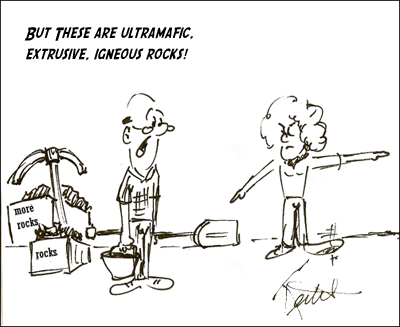
Rocks: aggregates of minerals.
Three types of rocks: Igneous, Sedimentary and Metamorphic
Rock Cycle: a description of the processes whereby rocks change from one type to another.
Two main classifications: Intrusive (plutonic) and extrusive (volcanic).
Igneous rocks form from the crystallization or solidification of magma or lava.
Plutonic igneous rocks form from the slow cooling of magma and develop large crystals and a coarse-grained texture.
Volcanic igneous rocks form from the rapid cooling of lava and have a fine-grained texture, a glassy texture (quenching), or a frothy texture. Crystals do not have enough time to grow and develop.
Igneous rocks are classified on the bases of texture and mineral composition.
Textures include: coarse-grained, fine-grained, glassy, frothy and porphyritic (mixed) texture.
| Types | Coarse | Fine |
|---|---|---|
| Ultramafic | Peridotite | Kolmatite |
| Basaltic | Gabbro | Basalt* |
| Andesitic | Diorite | Andesite |
| Granitic | Granite* | Rhyolite |
*Most common types
 |
Mechanical: physical breaking up of rocks.
Chemical: changes in chemical composition
Breaking into smaller pieces increases surface area. More surface exposed increases the rate of chemical weathering.
Water contains dissolved oxygen and carbon dioxide. Some important chemical reactions are:
reaction with oxygen to form oxides
reaction with weak acids to dissolve minerals into solution
Feldspar weathers to form clay and quartz weathers to form sand.
Sedimentary rocks are formed from compacted and cemented sediment. There are two main types: chemical and detrital. The sediment is formed from weathering and erosion. Agents of erosion include running water, winds, waves and glacial ice.
Lithification: compaction and cementation
Sedimentary Rocks account for 5% by volume of Earth's outer 10 miles but 75% of rock outcrops are sedimentary.
Coal is a valuable sedimentary rock (and is not composed of minerals)
Sedimentary rocks typically produce beds or strata
Meta (Greek): change
Morph (Greek): shape or form
Rocks that are formed from other rocks through processes of applied pressure and heat or chemical reactions causing changes in appearance. Pressure and temperature increase with depth below the Earth's surface.
Foliated texture: minerals become aligned resulting in a banded appearance.
Examples of Metamorphic Rock